1. Zavedení
Mosaz vs bronz, Dvě prominentní slitiny na bázi mědi, sloužily civilizaci po tisíciletí.
Zatímco jejich teplý kovový lesk a podobná nomenklatura často matou, tyto slitiny mají odlišné chemické složení, vlastnosti, a aplikace.
Od jejich rolí ve starověkých zbraních a ražení mincí až po moderní použití v elektrických systémech a mořském prostředí,
rozhodování mezi mosaznými a bronzovými závěsy podle mnoha kritérií: Mechanický výkon, chemická odolnost, estetické preference, a efektivita nákladů.
Pochopení jejich nuancí je zásadní pro výběr správného materiálu pro správnou funkci.
2. Co je Brass?
Mosaz je a slitina mědi a zinku známý pro své vynikající zpracovatelnost, atraktivní zlatý vzhled, a střední mechanická pevnost.
V závislosti na obsahu zinku a přítomnosti dalších legujících prvků, mosaz může vykazovat širokou škálu fyzikálních, mechanický, a chemické vlastnosti.

Je to jedna z nejuniverzálnějších konstrukčních slitin a je široce používána elektrické komponenty, dekorativní předměty, instalatérské příslušenství, hudební nástroje, a precizně opracované díly.
Charakteristickým znakem mosazi je její laditelné složení: úpravou poměr mědi a zinku a zavádění menších prvků, jako je např vést, cín, hliník, mangan, křemík, nebo železo,
inženýři mohou přizpůsobit výkon slitiny tak, aby vyhovoval konkrétním aplikacím.
Chemické složení & slitinové systémy
Mosazi jsou obvykle klasifikovány na základě jejich fázová struktura a obsah zinku:
- Alpha Brass (α-mosaz)
-
- Obsah zinku: Až ~37 %
- Struktura: Jednofázový pevný roztok
- Vlastnosti: Výborná zpracovatelnost za studena, vysoká tažnost, Dobrá odolnost proti korozi
- Aplikace: Hluboká kresba, Spinning, tváření za studena
- Alfa-Beta mosaz (Duplexní mosaz)
-
- Obsah zinku: 37–45 %
- Struktura: Dvoufázový (A + b)
- Vlastnosti: Silnější a tvrdší, ale méně tažný; vhodné pro práci za tepla
- Aplikace: Výkovky, tělesa ventilu, Herce-Tuty Fittings
- Olověná mosaz (Volnořezná mosaz)
-
- Obsah olova: ~1–3 %
- Vlastnosti: Vynikající obrobitelnost díky přítomnosti jemně rozptýlených částic olova
- Aplikace: Precizně opracované komponenty, instalatérské kování, upevňovací prvky
- Speciální slitiny mosazi
-
- Legující prvky jako např hliník (Al) pro pevnost a odolnost proti korozi, křemík (A) pro zlepšenou odolnost proti opotřebení, a cín (Sn) pro zvýšenou odolnost proti odzinkování
- Aplikace: Mořský hardware, elektrické terminály, dekorativní aplikace
Společné známky a standardy
| Stupeň | Norma | Typické složení | Vlastnosti a aplikace |
| C26000 | ASTM B135 | Cu 70%, Zn 30% | <p; vynikající zpracovatelnost za studena; používané v jádrech radiátorů, nábojnice, a dekorativní obložení |
| C36000 | ASTM B16 | Cu 61.5%, Zn 35.5%, Pb ~3% | Samořezná mosaz s vynikající obrobitelností; ideální pro automatické šroubovací stroje |
| H62 | GB/T. 5231 (Čína) | Cu 62%, Zn 38% | Univerzální mosaz s dobrou zpracovatelností za tepla; používané v spojovacích materiálech, díly ventilů, a nýty |
| H59 | GB/T. 5231 (Čína) | Cu 59%, Zn 41% | Pevnější, ale méně tažný; používané v mechanických konstrukčních součástech |
| CZ108 | BS EN 12163 | Podobně jako C27200 | Alfa mosaz; dobré vlastnosti při tváření za studena a svařování; používané v architektonickém hardwaru a obecném inženýrství |
3. Co je bronz?
Bronz je široká rodina slitiny na bázi mědi primárně legované cínem,
i když jiné prvky, jako je hliník, křemík, fosfor, a mangan jsou také běžná legovací činidla v moderních bronzových systémech.
Zatímco historicky se termín „bronz“ vztahoval výhradně na slitiny mědi a cínu, nyní zahrnuje širokou škálu slitin s různými vlastnostmi přizpůsobenými specifickým průmyslovým potřebám.
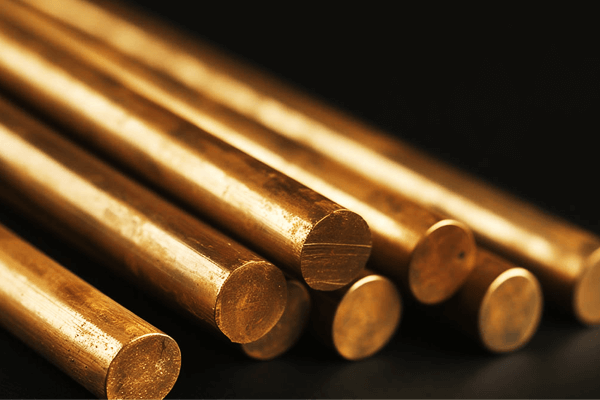
Bronz je známý pro své vysoká síla, Vynikající odolnost proti korozi, vynikající opotřebení, a schopnost vytvářet stabilní ochrannou patinu, zejména v drsném prostředí.
Používá se po tisíce let – od doby bronzové – a nadále je široce využíván Marine, strukturální, elektrický, umělecký, a ložiskové aplikace.
Klíčový rozdíl mezi mosazí a bronzem spočívá v jejich legujících prvcích: mosaz je především měď + zinek, zatímco bronz je obecně měď + cín (nebo jiné prvky jako Al, A, Str, Mn).
Bronz obvykle vykazuje vyšší pevnost, tvrdost, a odolnost proti korozi a únavě kovů, i když za vyšší cenu a nižší obrobitelnost ve srovnání s mosazí.
Chemické složení & slitinové systémy
Slitiny bronzu jsou klasifikovány podle jejich primárního legujícího prvku kromě mědi:
- Fosforový bronz (Cu–Sn–P)
-
- Obsah cínu: ~0,5–11 %, se stopovým množstvím fosforu
- Charakteristiky: Vysoká únavová odolnost, Nízké tření, vynikající pružinové vlastnosti
- Aplikace: Ložiska, prameny, elektrické konektory, rychlostní stupně
- Hliníkový bronz (Cu-Al)
-
- Obsah hliníku: ~5–12 %
- Charakteristiky: Výjimečná odolnost proti korozi (zejména ve slané vodě), vysoká síla
- Aplikace: Mořský hardware, ventily, čerpadla, letecká pouzdra
- Křemíkový bronz (Cu-Si)
-
- Obsah křemíku: ~2–6 %
- Charakteristiky: Dobrá slévatelnost, odolnost proti korozi, a mírná síla
- Aplikace: Architektonické kování, sochy, upevňovací prvky
- Manganový bronz (Cu–Zn–Mn–Fe)
-
- Technicky mosazná varianta, ale často seskupené s bronzy kvůli podobným pevnostním charakteristikám
- Charakteristiky: Vysoká pevnost v tahu, dobrá odolnost proti opotřebení
- Aplikace: Těžká ložiska, vrtulové hřídele, dříky ventilů
Společné známky a standardy
| Stupeň | Norma | Typické složení | Vlastnosti a aplikace |
| C51000 | ASTM B139 | Cu 95%, Sn 5%, P stopa | Fosforový bronz; vysoká odolnost proti únavě a pružinové vlastnosti; používané v pouzdrech, rychlostní stupně, Elektrické kontakty |
| C54400 | ASTM B139 | Cu 95%, Sn 4%, Pb 1% | Olovnatý fosforový bronz; zlepšená obrobitelnost pro přesné součásti |
| C63000 | ASTM B150 | Cu 83%, Al 10%, V 5%, Fe 2% | Nikl hliníkový bronz; vynikající odolnost proti korozi a pevnost; ideální pro lodní šrouby, čerpadla |
| C64200 | ASTM B150 | Cu 93.5%, Al 6%, A 0.5% | Silikonový hliníkový bronz; dobrá pevnost a odolnost proti korozi; používá se ve dříkech ventilů a upevňovacích prvcích |
| C86300 | ASTM B271 | Cu 70%, Mn 2.5%, Fe 3%, Zn 24% | Manganový bronz; vysoce pevná ložisková slitina; používá se pro nosné mechanické díly |
4. Mechanický výkon mosazi vs bronz
Při výběru mezi bronzem a mosazí pro strojírenské aplikace, mechanický výkon je kritickým kritériem.
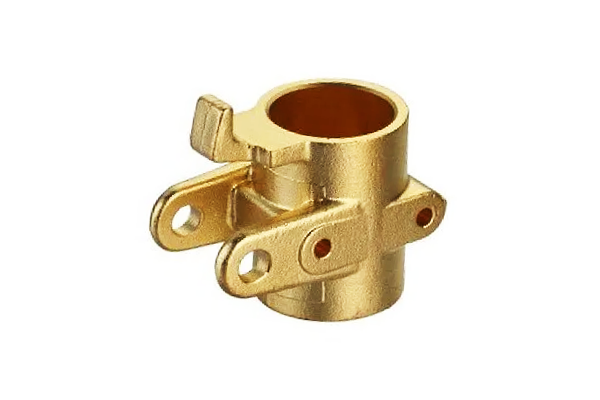
Zatímco oba jsou slitiny na bázi mědi, jejich mechanické vlastnosti se výrazně liší v závislosti na složení, zpracování, a fázovou strukturu.
Porovnání mechanické pevnosti a tažnosti
| Typ slitiny | Pevnost v tahu (MPA) | Výnosová síla (MPA) | Prodloužení (%) | Houževnatost (Kvalitativní) |
| C26000 (Kazeta z mosazi) | 300–500 | 100–250 | 30–50 | Mírný |
| C36000 (Volnořezná mosaz) | 400–550 | 250–400 | 20–35 | Střední až Nízká (kvůli obsahu olova) |
| C51000 (Fosforový bronz) | 350–550 | 200–400 | 15–30 | Vysoký (vynikající při cyklické zátěži) |
| C54400 (Olovnatý fosforový bronz) | 400–600 | 250–450 | 12–25 | Vysoký |
| C63000 (Hliníkový bronz) | 550–800 | 300–600 | 10–20 | Velmi vysoká (odolný proti nárazu a únavě) |
| C86300 (Manganový bronz) | 600–850 | 400–600 | 10–20 | Vysoký |
Tvrdost (Brinell, Vickers, Rockwell)
| Typ slitiny | Brinell (HB) | Vickers (Hv) | Rockwell (B/H) |
| C26000 mosaz | ~65–110 | ~80–120 | ~RB 60–80 |
| C36000 Volné řezání | ~110–150 | ~120–160 | ~RB 80–95 |
| Bronz C51000 Phos | ~80–130 | ~100–160 | ~RB 70–85 |
| C63000 Al bronz | ~150–200 | ~180–230 | ~RC 25–35 |
| C86300 Mn bronz | ~170–230 | ~200–270 | ~RC 25–35 |
Únavový život při cyklickém zatížení
| Typ slitiny | Limit vytrvalostí (MPA) | Poznámky |
| Alpha Brass (C26000) | ~100–150 | Citlivé na povrchové defekty a napětí |
| Al Bronz (C63000) | ~250–350 | Vynikající odolnost proti únavě |
| Fosforový bronz | ~150–250 | Vynikající pro aplikace s cyklickými pružinami |
5. Mosaz vs bronz: Fyzikální & Srovnávací tabulka tepelných vlastností
| Vlastnictví | Mosaz (Typický rozsah) | Bronz (Typický rozsah) | Poznámky |
| Hustota | 8.3 - 8.7 g/cm³ | 7.5 - 8.9 g/cm³ | Bronz se více liší podle legujících prvků (např. cín, hliník, mangan) |
| Specifická síla | 45 - 65 kN·m/kg | 55 - 85 kN·m/kg | Bronz je obecně silnější na jednotku hmotnosti |
| Tepelná vodivost | 95 - 130 W/m · k | 35 - 70 W/m · k | Mosaz lépe vede teplo; ideální pro termotransferové díly |
| Tepelná difuzivita | ~3,5 – 4.0 mm²/s | ~1,8 – 2.8 mm²/s | Mosaz šíří teplo rychleji; bronz tlumí tepelné změny |
| Koeficient tepelné roztažnosti (CTE) | ~20 – 21 × 10⁻⁶/K | ~16 – 18 × 10⁻⁶/K | Bronz nabízí lepší rozměrovou stabilitu při kolísání teplot |
| Specifická tepelná kapacita | ~0,38 J/g.K | ~0,35 J/g.K | Mosaz o něco lepší pro akumulaci tepla |
| Odolnost proti tepelným šokům | Mírný | Vysoký | Bronz odolává praskání při rychlých změnách teploty |
| Rozměrová stabilita | Střední až Nízká | Vysoký | Bronz preferovaný v prostředí přesných tepelných cyklů |
6. Akustický & Estetické vlastnosti mosazi vs bronzu
Rezonance a tlumení v hudebních nástrojích (zvony, činely, struny)
- Žesťové nástroje: Mosaz je primární materiál pro hudební nástroje, jako jsou trubky, pozouny, a rohy.
Jeho relativně vysoká akustická impedance a dobré rezonanční vlastnosti mu umožňují produkovat jasný, mocné zvuky.
Schopnost slitiny volně vibrovat na určitých frekvencích dává žesťovým nástrojům jejich charakteristické bohaté tóny. - Bronz v bicích nástrojích: Bronz je široce používán v bicích nástrojích, jako jsou zvony, činely, a gongy.
Cín-bronzy, zejména, jsou známé svými vynikajícími akustickými vlastnostmi.
Mají unikátní kombinaci rezonance a tlumení, což má za následek teplo, bohatý zvuk s dlouhým sustainem.
Například, kostelní zvony vyrobené z bronzu produkují hluboké, sonorní tóny, které se mohou přenášet na velké vzdálenosti.
Barevné spektrum: povrchová úprava žlutá mosaz vs. načervenalý bronz vs
- Barva mosazi: Barva mosazi se liší v závislosti na obsahu zinku. Nízkozinkové mosazi mají červenožlutý odstín, zatímco mosazi s vyšším obsahem zinku jsou více zlatožluté.
Tento světlý, Díky atraktivní barvě je mosaz oblíbenou volbou pro dekorativní aplikace, jako je hardware, šperky, a architektonické akcenty. - Barva bronzu: Bronz má typicky červenohnědou barvu, které se mohou mírně lišit v závislosti na složení slitiny.
V průběhu času, bronz může vyvinout patinu, která se může pohybovat od zelenomodré (ve venkovním prostředí) do tmavší hnědé, přidává na jeho estetické přitažlivosti, zejména v umění a architektonických sochách. - Pozlacené povrchy: Jak mosaz, tak bronz mohou být opatřeny zlacením, aby se zlepšil jejich vzhled.
Pozlacené povrchové úpravy se mohou pohybovat od jasných zlatých povlaků až po starožitnější patiny, umožňující širokou škálu estetických možností v dekorativních výrobcích.
Dekorativní techniky: lept, patinování, Posunutí
- Lept: Mosaz i bronz lze leptat a vytvářet tak složité vzory. Leptání zahrnuje použití chemikálií k selektivnímu odstranění materiálu z povrchu, odhalení požadovaného vzoru.
Tato technika se běžně používá při výrobě dekorativních plaket, mince, a uměleckých předmětů. - Patinování: Jak již bylo zmíněno dříve, bronz časem přirozeně vyvine patinu. Však, patinování lze také uměle vyvolat pro dosažení specifických estetických efektů.
V mosazi, techniky patinování lze použít k vytvoření starých nebo starožitně vyhlížejících povrchových úprav. - Posunutí: Pokovování je další oblíbenou dekorativní technikou. Mosaz může být pokovena zlatem, stříbro, nebo nikl pro vylepšení jeho vzhledu a ochranu před korozí.
Bronz lze také pokovovat, i když je méně častý kvůli jeho přirozené estetické přitažlivosti a možnosti, že pokovení naruší vývoj jeho charakteristické patiny.
7. Elektrický & Magnetické vlastnosti bronzu vs
Mosaz vs. bronz vykazují odlišné elektrické a magnetické chování, které ovlivňuje jejich vhodnost v elektrotechnice, elektronický, a elektromagnetického rušení (EMI) Aplikace.
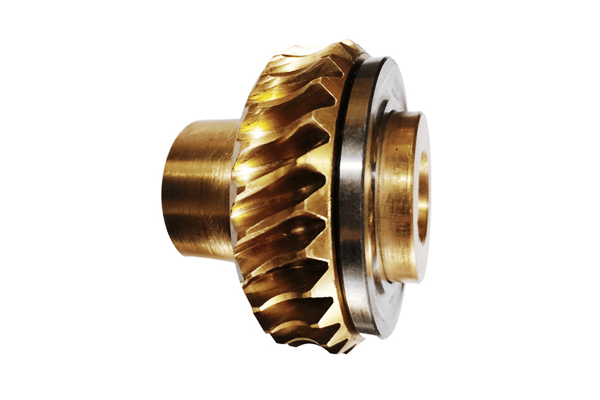
Elektrická vodivost
| Materiál | Elektrická vodivost (% IAC)* | Typické aplikace |
| Mosaz (C26000) | 15 - 28% | Elektrické konektory, terminály, přepínače |
| Fosforový bronz (C51000) | 5 - 8% | Prameny, konektory, nízkoproudé kontakty |
| Hliníkový bronz (C63000) | 7 - 10% | Konektory odolné proti korozi, speciální kontakty |
IACS = International Annealed Copper Standard (100% = vodivost čisté mědi)
- Slitiny mosazi obecně nabídnout střední elektrická vodivost, dostatečné pro mnoho elektrických součástek, kde je vodivost a mechanická pevnost v rovnováze.
- Bronzové slitiny mít nižší elektrická vodivost, především díky jejich legujícím prvkům (cín, fosfor, hliník),
takže jsou méně vhodné tam, kde je vyžadována vysoká elektrická vodivost, ale cenné tam, kde je upřednostňována mechanická pevnost a odolnost proti korozi.
Magnetické vlastnosti
| Materiál | Magnetická propustnost (µr) | Magnetické chování |
| Mosaz | ~1,0 (nemagnetické) | V podstatě nemagnetické |
| Fosforový bronz | ~1,0 (nemagnetické) | Nemagnetický |
| Manganový bronz | Mírně magnetické | Může vykazovat slabý magnetismus |
- Obě mosaz a většina slitin bronzu jsou nemagnetické, což je výhodné v aplikacích vyžadujících minimální magnetické rušení.
- Některé specializované bronzy jako manganový bronz mohou vykazovat nepatrné magnetické vlastnosti, ale zůstávají převážně neferomagnetické.
Úvahy o stínění EMI/RFI
- Díky střední vodivosti a nemagnetické povaze, mosaz se často používá v Komponenty stínění EMI/RFI jako jsou konektory a kryty, vyrovnávání vodivosti s mechanickou robustností.
- Nižší vodivost bronzu snižuje jeho účinnost při stínění ve srovnání s mosazí,
ale díky vynikající odolnosti proti korozi je vhodný pro drsná prostředí, kde je stínění EMI sekundární. - Pokovování vysoce vodivými kovy (NAPŘ., stříbro nebo měď) na mosazi nebo bronzu může zlepšit povrchovou vodivost pro lepší EMI/RFI výkon.
8. Odolnost proti korozi & Povrchové chování
- Odzinkování: Mosaz může trpět vyluhováním zinku v korozivním prostředí nebo prostředí s vysokým obsahem chloridů, oslabení materiálu.
- Vyluhování cínu: Bronz lépe odolává obecné korozi a nepodléhá odzinkování, ačkoli se cín může vyluhovat ve velmi kyselém prostředí.
- Praskání koroze: Mosaz je náchylnější, zejména v prostředích bohatých na amoniak.
- Námořní výkon: Hliníkové a křemíkové bronzy jsou výjimečně odolné proti korozi, široce používané v námořní a pobřežní stavby.
- Patina: Bronzové formy a stabilní, ochranná patina, zatímco mosaz zmatní a může vyžadovat leštění nebo těsnění.
9. Výroba & Formování mosazi vs bronzu
Casting Chování: Tekutost, Srážení, a poréznost
Obsazení zůstává primární výrobní cestou pro mnoho mosazných a bronzových součástí. Pochopení jejich odlévacích vlastností pomáhá optimalizovat design a minimalizovat vady.

- Mosaz vykazuje vynikající tekutost, s hodnotami dosahujícími přibližně 40–45 cm na stupnici testu tekutosti, umožňující složité geometrie, jako jsou detailní architektonické armatury a přesné ventily.
Míra jeho smrštění se obvykle pohybuje mezi 1.5% a 2.0%, což pomáhá udržovat rozměrovou přesnost. - Naopak, slitiny bronzu vykazují střední tekutost, v rozmezí cca 30-38 cm, který zpochybňuje odlévání velmi tenkostěnných nebo složitých tvarů.
Smrštění se může zvýšit na 2.0% na 2.5%, což vyžaduje přídavek v konstrukci formy, aby se zabránilo vadám odlitku.
Pórovitost je více rozšířená u bronzových odlitků, zejména bez optimalizovaných režimů chlazení, ovlivňující mechanickou integritu.
Studená práce: Meze tažnosti a tváření
Zpracování za studena tvaruje kovy pod jejich teplotou rekrystalizace, zvýšení pevnosti deformačním zpevněním, ale vyžadující dostatečnou tažnost.
- Mosaz se leskne při zpracovatelnosti za studena díky obsahu zinku a mikrostruktuře, často dosahují hodnot prodloužení mezi 30–50% v tahových zkouškách po žíhání.
To umožňuje rozsáhlé operace, jako je hluboké tažení, ohýbání s malými poloměry (až 3–5 mm v listech), a jemným tažením drátu. - Tažnost bronzu se liší podle legujících prvků; například, fosforový bronz vykazuje prodloužení mezi 15–35 %, zatímco hliníkový bronz klesá na 10–20 %.
Tváření těchto slitin za studena vyžaduje větší poloměry ohybu (obvykle >10 mm) a středním žíháním, aby se zabránilo praskání.
Horká práce & Žíhání: Teplota a odezva
Opracování za tepla zjemňuje mikrostrukturu a umožňuje deformaci za hranice tváření za studena.
- Mezi nimi účinně žíhá mosaz 450°C a 600 °C, s rekrystalizací dokončenou během několika minut.
Válcování nebo kování za tepla vytváří jednotnou velikost zrna, zlepšení houževnatosti a tažnosti. - Bronz vyžaduje vyšší teploty – často 600° C až 900 ° C. — a delší doby žíhání, někdy i několik hodin, obnovit tažnost.
Hliníkový bronz, například, vyžaduje pečlivou kontrolu, aby se zabránilo hrubnutí zrna, které může zhoršit mechanické vlastnosti.
Obrobitelnost a obrábění: Efektivita a výzvy
Obrobitelnost ovlivňuje doby cyklu, náklady na nástroje, a kvalitu povrchové úpravy.
- Hodnocení obrobitelnosti mosazi se pohybuje od 70% na 100% vzhledem k volně obráběným mosazným standardům.
Vyrábí kontinuálně, snadno ovladatelné třísky a vyžaduje mírné řezné síly.
Karbidové nástroje efektivně manipulují s mosazí, umožňující vysokorychlostní obrábění s minimálním opotřebením nástroje. - Obrobitelnost bronzových slitin je variabilnější a obecně nižší, s hodnocením mezi 40% a 70%.
Hliníkové bronzy a manganové bronzy jsou zvláště abrazivní, zvýšení míry opotřebení nástrojů.
Obrábění bronzu často vyžaduje nástroje na bázi kobaltu nebo keramiky a snížené řezné rychlosti, aby se zachovala životnost nástroje.
10. Připojování & Montáž mosaz vs bronz
Spojení mosazných a bronzových komponentů je kritickou součástí jejich použití v instalatérství, elektrické systémy, konstrukčních sestav, a umělecká díla.
Pájení mosazi vs. pájení bronzu
Mosazné pájení:
Mosaz je velmi vhodná pro měkké i tvrdé pájení díky své příznivé tepelné vodivosti a kompatibilitě s běžnými přídavnými materiály.
- Měkké pájení (< 450° C.) je ideální pro lehké aplikace, jako jsou šperky, malé elektronické terminály, a dekorativní komponenty.
- Pájky na bázi olova (NAPŘ., Sn-Pb 60/40) poskytují dobré smáčení a střední pevnost; však,
bezolovnaté pájky (NAPŘ., Sn-Ag nebo Sn-Cu) jsou nyní široce přijímány pro produkty vyhovující RoHS. - Tvrdé pájení (stříbrné pájení) používá pájky s vysokou teplotou tání (450–800 °C),
jako jsou slitiny Ag-Cu-Zn, k vytvoření pevných spojů v žesťových hudebních nástrojích, těžké vodovodní armatury, a mechanické spoje.
Bronzové pájení:
Pájení je preferovanou metodou spojování bronzu kvůli jeho vyššímu bodu tání a požadavkům na pevnost.
- Typické teploty pájení se pohybují od 750°C až 950 °C, v závislosti na složení slitiny.
- Cín-bronz a fosforový bronz jsou často pájeny pomocí přídavných kovů Cu-P nebo Cu-Sn, vybrány tak, aby co nejlépe odpovídaly vlastnostem obecných kovů a omezovaly galvanické efekty.
- Hliníkové a manganové bronzy vyžadují speciální plniva s odpovídajícím obsahem hliníku, aby se předešlo nesouladu fází a intermetalické tvorbě.
- K zabránění oxidace během vysokoteplotního spojování jsou často nutné tavidla nebo inertní atmosféra.
Mechanické spojování (Vlákna, Stiskněte Fits)
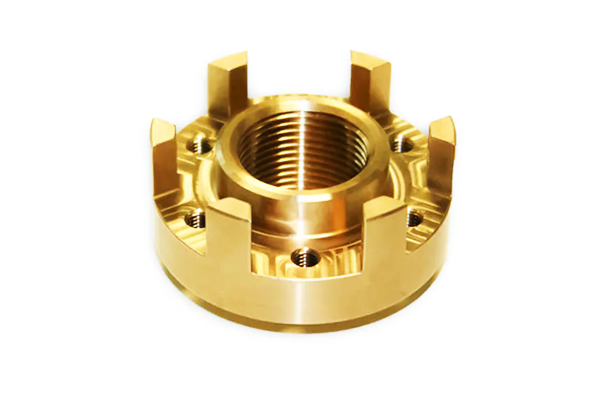
Mechanické spojování mosazi:
- Díky vynikající obrobitelnosti mosazi je ideální pro závitové spoje, zejména v systémech pro manipulaci s kapalinami, jako jsou např potrubní spojky, ventily, a pouzdra snímačů.
- Lisovací uložení se běžně používají v aplikacích s nízkou až střední zátěží.
Tažnost mosazi umožňuje mírnou elastickou deformaci během vkládání, zajišťující pevný spoj odolný proti vibracím.
Bronzové mechanické spojování:
- Vzhledem k jeho vyšší tvrdost a pevnost, bronzové součásti používané v náročných aplikacích (NAPŘ., Ložiskové pouzdra, námořní ventily) často spoléhají na robustní tvary závitů a užší tolerance lisovaného uložení.
- Tvrdší slitiny bronzu jako manganový bronz nebo beryliový bronz vyžadují přesné obrábění a někdy předhřání krytů, aby se umožnilo snadnější uložení s přesahem bez vzniku trhlin.
Srovnání:
- Rychlost řezání závitů: Mosaz – vysoká (300– 400 SFM); Bronzová – střední (150– 250 SFM)
- Stiskněte Přizpůsobit rozsah tolerance (pro hřídel ⌀25 mm): Mosaz ~25–50 µm; Bronz ~15–35 µm
Kompatibilita s lepidlem
Lepení mosazným lepidlem:
- Mosaz se dobře spojuje epoxidy, kyanoakryláty, a anaerobní lepidla, zejména u málo namáhaných sestav.
- Pro dosažení nejlepších výsledků:
-
- Čistěte isopropylalkoholem nebo acetonem
- Lehce obruste povrch pro zvětšení kontaktní plochy
- Naneste lepidlo a svorku po dobu 5–30 minut v závislosti na složení
Aplikace zahrnují ozdobné držáky, číselníkové úchylkoměry, a okrasné stavby.
Bronzové lepení:
- Bronz vyžaduje více přísná příprava povrchu kvůli rychlé tvorbě oxidů.
-
- Doporučeno: chemické leptání (NAPŘ., kyselina fosforečná) nebo otryskáním s následným okamžitým lepením.
- Vysoce pevná epoxidová lepidla s prodloužením >5% jsou preferovány, zejména pro konstrukční spoje nebo spoje náchylné k vibracím.
Vhodné pro nástrojové vložky, strukturální oprava, a umělecké instalace, zejména tam, kde svařování není možné.
11. Klíčové průmyslové aplikace mosazi vs. bronzu
Mosaz a bronz si vydobyly své místo v moderním průmyslu po staletí spolehlivého výkonu.
Jejich odlišná kombinace mechanické pevnosti, odolnost proti korozi, a zpracovatelnost je činí nepostradatelnými v celé řadě odvětví.
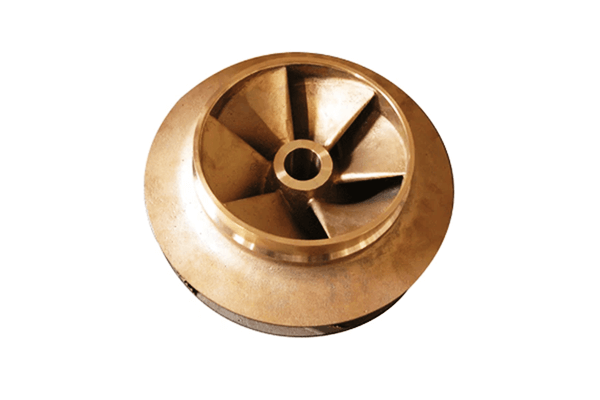
Průmyslové aplikace mosazi
Instalatérské systémy a systémy pro manipulaci s kapalinami
Vynikající obrobitelnost mosazi, odolnost proti korozi v pitné vodě, a těsnící schopnost z něj činí kov volby pro komponenty jako:
- Potrubí
- Ventily
- Faucety
- Kompresní rukávy
- Rozstřikovací trysky
Elektrotechnický a elektronický průmysl
Dobrá elektrická vodivost a nemagnetické vlastnosti mosazi jsou ideální pro elektrický hardware, například:
- Svorkovnice a zásuvky
- Konektory a spínací kontakty
- Kabelová oka a zemnící svorky
- Deska s plošnými spoji (PCB) odstupy
Přesné přístroje a hodiny
Jeho rozměrová stabilita a nízké třecí vlastnosti podporují jeho použití v:
- Ozubená kola a hodinová kola
- Kalibrační knoflíky
- Ciferníky a rámečky
Dekorativní architektura a kování
Zlatá estetika mosazi a odolnost proti zašpinění umožňují dlouhodobé používání:
- Kliky a zámky dveří
- Zábradlí a architektonické obložení
- Hudební nástroje (trubky, rohy)
- Svítidla a okrasné mříže
Automobilové a letecké komponenty
Mosaz se používá tam, kde je kritický elektrický výkon a odolnost proti korozi:
- Radiátorová jádra a topná tělesa
- Armatury brzdového potrubí
- Pouzdra snímačů paliva
Munice a obranný průmysl
Díky své tažnosti a odolnosti vůči korozi, mosaz je široce používána v:
- Pouzdra na kazety
- Skořápkové obaly
- Pojistkové komponenty
Průmyslové aplikace bronzu
Ložiska a pouzdra
Slitiny bronzu – zejména cín-bronz a olovnatý bronz – nabízejí vynikající odolnost proti opotřebení a zabudovatelnost, zásadní pro:
- Kluzná ložiska
- Přítlačné podložky
- Vodicí pouzdra v hydraulických systémech
Marine a Offshore Engineering
Díky vynikající odolnosti vůči korozi slané vody je bronz nepostradatelný:
- Vrtule a oběžná kola
- Sedla ventilů a tělesa čerpadel
- Součásti potrubí pro mořskou vodu
- Skříně ponorných motorů
Těžká zařízení a průmyslové stroje
Pro vysokou zátěž, nízkorychlostní aplikace, bronzové komponenty pomáhají snižovat tření a opotřebení:
- Ozubená kola a šnekové převody
- Posuvné otěrové desky
- Ložiskové klece a těsnění
Letecký a kosmický průmysl a obranné systémy
Speciální bronzy, jako je hliníkový bronz a berylliový bronz, se používají v kritických aplikacích, kde je klíčem pevnost a odolnost proti únavě:
- Konstrukční spojovací prvky
- Vysoce namáhaná pouzdra podvozku
- Elektrické konektory s pružinovými vlastnostmi
Sochařství a výtvarné umění
Díky svým odlévacím vlastnostem a tvorbě patiny, bronz je tradiční a současný materiál pro:
- Monumentální sochy
- Medaile a pamětní desky
- Umělecké odlitky a restaurování
Aditivní výroba a pokročilá výroba
S růstem kovového 3D tisku, zkoumají se určité slitiny bronzu:
- Umělecká díla na zakázku
- Nástroje s vysokým opotřebením
- Prototypování mechanických součástí s estetickou hodnotou
12. Výhody a nevýhody bronzu vs
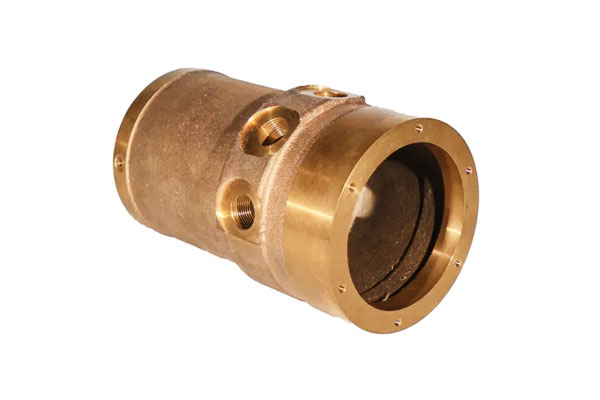
Mosaz Pros:
- Vynikající machinabilita
- Vysoká vodivost
- Cenově dostupné
- Dobrá estetická rozmanitost
Brass Nevýhody:
- Riziko odzinkování
- Nižší pevnost
- Sklon k zašpinění
Bronzové Pros:
- Vysoká pevnost a odolnost proti opotřebení
- Vynikající odolnost proti korozi
- Vynikající pro ložiska a námořní díly
- Krásná patina postupem času
Bronzové nevýhody:
- Těžší stroj
- Dražší
- Nižší tepelná a elektrická vodivost
13. Srovnávací tabulka: Mosaz vs bronz
| Kategorie | Mosaz | Bronz |
| Základní složení | Měď + Zinek | Měď + Cín (nebo jiné prvky) |
| Běžné legované prvky | Zinek, Vést (volné obrábění), Nikl (nikl stříbro) | Cín, Hliník, Křemík, Fosfor, Mangan, Berylium |
| Barva | Světle zlatá až žlutá (vyšší Zn) | Červenohnědá, někdy zlatá; patiny v průběhu času |
| Hustota (g/cm³) | ~8,4–8,7 | ~8,7–8,9 |
| Pevnost v tahu (MPA) | 300–550 | 350–800 (Hliníkový bronz až 900 MPA) |
| Výnosová síla (MPA) | 100–350 | 200–600 |
| Prodloužení (%) | 20–50 | 10–35 |
| Tvrdost (Brinell HB) | 50–150 (se liší podle slitiny) | 60–210 (Hliníkový bronz může převyšovat 200 HB) |
| Tepelná vodivost (W/m · k) | ~100–130 | ~50–70 (Cínový bronz); jak nízké jako 35 pro některé hliníkové bronzy |
| Elektrická vodivost (%IAC) | 28–40% | 7–15% (mnohem nižší díky cínu nebo hliníku) |
| Odolnost proti korozi | Dobrý; náchylné k odzinkování v čpavku/fyziologickém roztoku | Vynikající, zejména v mořském prostředí; imunní vůči odzinkování |
| Zpracovatelnost (Machinability) | Vynikající, zejména s olovnatou mosazí | Mírné až dobré; se značně liší podle typu slitiny |
| Castiability | Velmi dobré | Vynikající, zejména pro umělecké odlitky |
| Studená zpracovatelnost | Vynikající; lze kreslit, orazítkováno, předený | Mírný; omezenější pro tvrdší bronzy |
| Náklady | Obecně nižší | Obecně vyšší, zejména hliník a speciální bronzy |
Kvalita zvuku (Hudební využití) |
Jasný, ostré tóny (trubky, rohy) | Teplý, rezonanční tóny (zvony, činely, gongy) |
| Tvorba patiny | Časem se zbarví do tmavě hnědé nebo zelené | Po dlouhou dobu vytváří esteticky příjemnou zeleno-modrou patinu |
| Magnetická propustnost | Nemagnetický | Nemagnetický (některé hliníkové bronzy mohou být slabě magnetické) |
| Pájení/pájení | Snadno pájené; zinek může během svařování těkat | Typicky pájené; speciální výplňové slitiny potřebné pro vysoký výkon |
| Námořní vhodnost | Omezené – pouze specifické slitiny (NAPŘ., námořní mosaz) | Vynikající – ideální pro části vystavené mořské vodě |
| Klíčové průmyslové aplikace | Instalatérské armatury, hudební nástroje, elektrické konektory | Ložiska, pouzdra, lodní šrouby, sochařství, Aplikace s vysokým zatížením |
| Recyclabality | Vysoce recyklovatelné | Vysoce recyklovatelné |
14. Závěr
Mosaz a bronz, zatímco chemicky podobné jsou slitiny na bázi mědi, nabízejí zcela odlišné vlastnosti a aplikace.
Mosaz exceluje v vodivost, Formovatelnost, a náklady, takže je ideální pro použití v elektroinstalaci a instalatérství. Bronz vyniká v pevnost, odolnost proti korozi, a dlouhověkost
Výběr mezi mosazí a bronzem vyžaduje podrobné pochopení požadavky na výkon, podmínky prostředí, a nákladová omezení.
Vyrovnáním materiálových charakteristik s požadavky aplikace, inženýři a designéři mohou zajistit dlouhou životnost, spolehlivost, a estetickou hodnotu svých výrobků.
Časté časté
Což je lepší: Bronz nebo mosaz?
Záleží na aplikaci.
- Mosaz je lepší pro aplikace vyžadující Dobrá machinabilita, Elektrická vodivost, a a jasný, dekorativní vzhled, například instalatérství, hudební nástroje, a elektrické konektory.
- Bronz je vhodnější pro vysokopevnostní, odolný proti opotřebení, a odolný vůči korozi Aplikace, zvláště v Marine, ložisko, a Těžké stroje prostředí.
Stručně řečeno:
- Vybrat mosaz pro estetiku a snadné tvarování.
- Vybrat bronz pro sílu, trvanlivost, a drsným prostředím.
Je dražší mosaz nebo bronz?
Bronz je obecně dražší než mosaz.
- Je to dáno jeho vyšším obsahem cín, hliník, nebo jiné speciální prvky jako beryllium, které jsou dražší než zinek (používané v mosazi).
- Navíc, slitiny bronzu mívají složitější zpracování a často se používají v kritické nebo vysoce výkonné aplikace, další zvyšování nákladů.
Jak poznáte, zda je to bronz nebo mosaz?
Tady jsou klíčové způsoby rozlišování mezi mosazí a bronzem:
- Barva:
-
- Mosaz: Žlutá až zlatá, v závislosti na obsahu zinku.
- Bronz: Červenohnědá, často tmavší nebo s patinou.
- Zvuk (Tonální kvalita):
-
- Jemně udeřte do předmětu: Mosaz často zní výše posazené a „zvonivé“, zatímco bronz dává hlubší, zvučnější tón.
- Magnetismus:
-
- Oba jsou nemagnetické, ale slitiny bronzu mohou obsahovat stopy železa nebo jiných prvků, které vykazují slabé magnetické chování.
- Jiskrová zkouška (pokud je bezpečné provést):
-
- Bronz vyrábí kratší, červenější jiskry, zatímco mosazné jiskry jsou jasnější a více žlutobílé.
Proč se bronz již příliš nepoužívá?
Bronz se stále používá, ale:
- Stalo se to méně časté u spotřebního zboží kvůli vyšší náklady na materiál a nárůst ekonomičtějších alternativ jako mosaz, Plasty, a nerezová ocel.
- Mosaz, jednodušší na obrábění a levnější na výrobu, má nahradil bronz v mnoha nekritických aplikacích, kde není nutná ultra vysoká pevnost nebo odolnost proti korozi.
- V moderní strojírenství, bronz je vyhrazen pro konkrétní role (NAPŘ., lodní šrouby, pouzdra) kde jsou podstatné jeho jedinečné vlastnosti.



